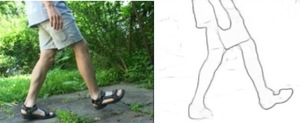Occlusion Boundary: A Formal Definition & Its Detection via Deep Exploration of Context
2020
Article
ps
Occlusion boundaries contain rich perceptual information about the underlying scene structure and provide important cues in many visual perception-related tasks such as object recognition, segmentation, motion estimation, scene understanding, and autonomous navigation. However, there is no formal definition of occlusion boundaries in the literature, and state-of-the-art occlusion boundary detection is still suboptimal. With this in mind, in this paper we propose a formal definition of occlusion boundaries for related studies. Further, based on a novel idea, we develop two concrete approaches with different characteristics to detect occlusion boundaries in video sequences via enhanced exploration of contextual information (e.g., local structural boundary patterns, observations from surrounding regions, and temporal context) with deep models and conditional random fields. Experimental evaluations of our methods on two challenging occlusion boundary benchmarks (CMU and VSB100) demonstrate that our detectors significantly outperform the current state-of-the-art. Finally, we empirically assess the roles of several important components of the proposed detectors to validate the rationale behind these approaches.
| Author(s): | Chaohui Wang and Huan Fu and Dacheng Tao and Michael J. Black |
| Journal: | IEEE Transactions on Pattern Analysis and Machine Intelligence |
| Volume: | 44 |
| Number (issue): | 5 |
| Pages: | 2641--2656 |
| Year: | 2020 |
| Month: | November |
| Department(s): | Perceiving Systems |
| Bibtex Type: | Article (article) |
| Paper Type: | Journal |
| DOI: | 10.1109/TPAMI.2020.3039478 |
| State: | Published |
| Links: |
official version
|
|
BibTex @article{Occlusion:PAMI:2020,
title = {Occlusion Boundary: A Formal Definition & Its Detection via Deep Exploration of Context},
author = {Wang, Chaohui and Fu, Huan and Tao, Dacheng and Black, Michael J.},
journal = {IEEE Transactions on Pattern Analysis and Machine Intelligence},
volume = {44},
number = {5},
pages = {2641--2656},
month = nov,
year = {2020},
doi = {10.1109/TPAMI.2020.3039478},
month_numeric = {11}
}
|
|



